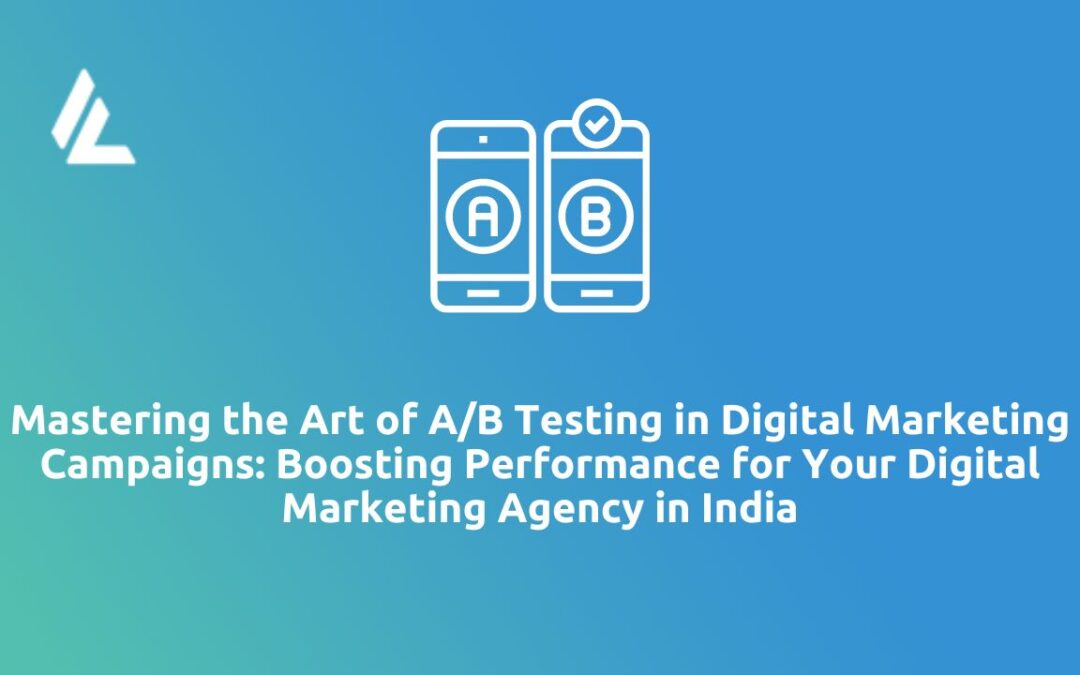Table of Contents
A/B testing is a crucial strategy for digital marketing agency in India to optimize their campaigns and achieve better results. In the dynamic landscape of digital marketing, A/B testing plays a significant role in measuring the impact of different variations and refining strategies accordingly. This article focuses on the benefits, essential elements, metrics, challenges, and best practices of A/B testing in digital marketing campaigns. By mastering the art of A/B testing, digital marketing agencies in India, including IndoAge, can unlock the potential to enhance their clients’ campaigns and stay ahead in the competitive market. Let’s delve into A/B testing and explore how it can revolutionize your digital marketing strategies.
Understanding A/B Testing in Marketing
A/B testing, also known as split testing, is a method used in digital marketing campaigns to compare different variations of a webpage, email, or ad. Its purpose is to measure the impact of changes on user behaviour and determine which variation performs better. By isolating and testing individual variables, such as headlines, design, or call-to-action, A/B testing allows marketers to understand how specific elements affect user engagement and conversions. This data-driven approach helps digital marketing agencies in India, including Indoage, make informed decisions and optimize their campaigns for maximum effectiveness.
Benefits of A/B Testing in Digital Marketing Campaigns
A/B testing offers several advantages for digital marketing agencies in India, including Indoage. It allows agencies to identify the most impactful elements within their campaigns and optimize their strategies accordingly. By conducting A/B tests, agencies can make data-driven decisions rather than relying on guesswork or assumptions.
The benefits of A/B testing extend to improved campaign performance and results. By experimenting with different variations, agencies can achieve higher conversion rates, increased customer engagement, and ultimately, a better return on investment (ROI). This is accomplished by understanding which elements resonate with their target audience and drive desired actions.
Moreover, A/B testing provides valuable insights into user behaviour and preferences. It helps agencies understand how changes in headlines, design, copy, or call-to-action impact user responses. Armed with this data, agencies can refine their marketing strategies, optimize campaigns, and enhance overall performance.
Overall, A/B testing empowers digital marketing agency in India to maximize the effectiveness of their campaigns, increase conversions, and achieve measurable results in a competitive market.
Key Elements to A/B Test in Digital Marketing Campaigns :
When conducting A/B testing in digital marketing campaigns, it is essential to focus on key elements that significantly impact campaign performance. By testing these elements, digital marketing agencies, including Indoage in India, can optimize the user experience and enhance campaign performance. Here are the essential elements to consider:
Headlines and Copy: Test different variations of headlines, ad copy, or email subject lines to understand their impact on click-through rates and conversions. Compelling and persuasive messaging can significantly influence user engagement.
Call-to-Action (CTA): Experiment with different CTAs, such as button placement, wording, color, or size, to determine which drives the highest conversion rates. Small changes in the CTA can have a substantial impact on user behaviour.
Design and Layout: Test variations in website design, landing page layouts, or email templates to optimize the user experience. Elements such as color schemes, typography, and overall aesthetics can influence user engagement and conversions.
Images and Videos: Evaluate the impact of different visuals, including images and videos, on user engagement and conversion rates. Test different formats, placements, or content to determine the most effective media for your target audience.
Audience Segmentation: Divide your target audience into segments and test different variations of your campaigns tailored to each segment’s preferences. Personalizing the messaging and offers can enhance relevancy and drive higher conversions.
Testing these elements helps digital marketing agencies refine their strategies and create campaigns that resonate with their target audience. It allows for data-driven decision-making, ensuring that each element of the campaign is optimized for maximum performance. By continuously testing and iterating, agencies can improve the user experience, increase engagement, and drive better campaign results.
Key Metrics to Measure in A/B Testing
When conducting A/B testing in digital marketing campaigns, it is crucial to track and analyze key metrics that provide insights into the effectiveness of the testing variations. By monitoring these metrics, digital marketing agencies like Indoage in India can make data-driven decisions and optimize their campaigns. Here are important metrics to consider:
Conversion Rate: Measure the percentage of users who take the desired action, such as completing a purchase or filling out a form. A higher conversion rate indicates the effectiveness of the tested variations.
Click-Through Rate (CTR): Track the rate at which users click on a specific link or call to action. A higher CTR signifies that the tested elements are compelling and engaging for the audience.
Bounce Rate: Monitor the percentage of users who leave a webpage without taking any further action. A lower bounce rate indicates that the tested variations are capturing user interest and encouraging them to explore further.
Engagement Metrics: Analyze metrics such as time spent on a page, number of page views, or social media shares. These metrics provide insights into how users interact with the tested variations and indicate the level of engagement.
Revenue/ROI: Evaluate the impact of A/B testing variations on revenue generation or return on investment. By comparing the revenue or ROI of different variations, agencies can determine the most effective approach.
By measuring these metrics, digital marketing agencies can assess the effectiveness of their A/B testing variations and make informed decisions about optimizing their campaigns for better results. It ensures that the tested elements are driving desired actions, improving user engagement, and ultimately leading to a positive impact on revenue and ROI.

Common Challenges in A/B Testing and How to Overcome Them
A/B testing in digital marketing campaigns can encounter several challenges that can impact the reliability and accuracy of the results. To ensure more reliable results, digital marketing agencies like Indoage in India should address and overcome these challenges. Here are some common challenges and strategies to overcome them:
Insufficient Sample Size: One challenge is not having a large enough sample size, which can lead to inconclusive or unreliable results. To overcome this, ensure that your tests target a significant number of users or visitors, increasing the statistical power of the results.
Test Duration and Seasonality: Test results may be influenced by factors like seasonality or time of day. Run tests over an extended period to account for these variations and ensure accurate insights.
Interactions and Interference: Testing multiple variables simultaneously can lead to interactions and interference, where the effects of one variation impact the results of another. To overcome this, test one variable at a time, ensuring that each variation is isolated and its impact accurately measured.
Biased or Non-Representative Samples: Samples that are not diverse or representative of the target audience can introduce bias into the results. Ensure that your sample includes a diverse range of users to obtain more reliable insights.
Result Misinterpretation: Misinterpreting the results can lead to incorrect conclusions and misguided decision-making. To avoid this, carefully analyze the results, considering statistical significance, effect size, and potential confounding factors.
By being aware of these challenges and implementing the suggested strategies, digital marketing agencies can overcome obstacles and obtain more reliable results from their A/B testing efforts. This, in turn, enables agencies to make data-driven decisions and optimize their campaigns effectively.
Conclusion
In conclusion, A/B testing is a crucial strategy for digital marketing agencies in India, such as Indoage, to optimize their campaigns and drive better results. Throughout this article, we explored the benefits, key elements, metrics, challenges, and best practices of A/B testing in digital marketing campaigns. A/B testing allows agencies to identify impactful campaign elements, optimize user experience, and achieve higher conversion rates, engagement, and ROI. It is essential for agencies to implement best practices, including testing headlines, copy, design, and audience segmentation, while tracking metrics like conversion rate, CTR, bounce rate, and revenue/ROI. By embracing A/B testing and leveraging data-driven decision-making, a digital marketing agency in India can stay ahead in the competitive landscape and achieve optimized campaign performance.

